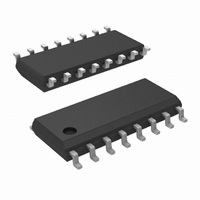LP2960AIM-5.0/NOPB National Semiconductor, LP2960AIM-5.0/NOPB Datasheet - Page 4

LP2960AIM-5.0/NOPB
Manufacturer Part Number
LP2960AIM-5.0/NOPB
Description
IC REG LDO 5V 500MA 16-SOIC
Manufacturer
National Semiconductor
Datasheet
1.LP2960IM-5.0NOPB.pdf
(16 pages)
Specifications of LP2960AIM-5.0/NOPB
Regulator Topology
Positive Fixed
Voltage - Output
5V
Voltage - Input
Up to 30V
Voltage - Dropout (typical)
0.47V @ 500mA
Number Of Regulators
1
Current - Output
500mA
Operating Temperature
-40°C ~ 125°C
Mounting Type
Surface Mount
Package / Case
16-SOIC (3.9mm Width)
Lead Free Status / RoHS Status
Lead free / RoHS Compliant
Current - Limit (min)
-
Other names
*LP2960AIM-5.0/NOPB
Available stocks
Company
Part Number
Manufacturer
Quantity
Price
Company:
Part Number:
LP2960AIM-5.0/NOPB
Manufacturer:
NS/TI
Quantity:
1 600
www.national.com
Electrical Characteristics
over the full operating temperature range. Unless otherwise specified: C
C
V
Exceeding the maximum allowable power dissipation will cause excessive die temperature, and the regulator will go into thermal shutdown. See APPLICATION
HINTS for additional information on heatsinking and thermal resistance.
Note 3: When used in dual-supply systems where the regulator load is returned to a negative supply, the output voltage must be diode-clamped to ground.
Note 4: May exceed the input supply voltage.
Note 5: Output or reference voltage temperature coefficient is defined as the worst case voltage change divided by the total temperature range.
Note 6: Output voltage load regulation is measured at constant junction temperature using low duty cycle pulse testing. Two separate tests are performed, one for
the load current range of 100 µA to 1 mA and one for the 1 mA to 500 mA range. Changes in output voltage due to heating effects are covered by the thermal
regulation specification.
Note 7: Dropout voltage is defined as the input to output differential at which the output voltage drops 100 mV below the value measured with a 1V differential. At
very low values of programmed output voltage, the input voltage minimum of 2V (2.3V over temperature) must be observed.
Note 8: Ground pin current is the regulator quiescent current. The total current drawn from the source is the sum of the ground pin current, output load current, and
current through the external resistive divider (if used).
Note 9: Dropout detection comparator threshold voltages are expressed in terms of a voltage differential measured at the Feedback terminal below the nominal
reference voltage, which is the reference voltage measured with V
the error amplifier gain which is V
Note 10: Thermal regulation is the change in output voltage at a time T after a change in power dissipation, excluding load or line regulation effects. Specifications
are for a 400 mA load pulse at V
Note 11: Connect a 0.1 µF capacitor from the output to the feedback pin.
Note 12: Vshutdown ≤ 1.1V, V
Note 13: Two separate tests are performed for reference voltage line regulation, one covering 2.5V ≤ V
≤ V
Note 14: All room temperature limits are 100% production tested. All limits at temperature extremes are guaranteed via correlation using standard Statistical
Quality Control (SQC) methods. All limits are used to calculate Average Outgoing Quality Level.
Note 15: Human Body Model, 200 pF discharged through 1.5 kΩ.
OUT
S/D
IN
= 2V. (Continued)
≤ 30V.
= 10 µF for 5V parts or C
IN
IN
O
<
/V
= V
30V, V
REF
OUT
O
(NOM) + 15V (6W pulse) for T = 10 ms.
= (R1 + R2)/R2 (see Basic Application Circuit).
OUT
= 22 µF for 3.3V parts, Feedback pin is tied to V
= 0V.
Limits in standard typeface are for T
IN
= V
O
(NOM) + 1V. To express these thresholds in terms of output voltage change, multiply by
4
IN
= 4.7 µF, V
J
= 25˚C, and limits in boldface type apply
IN
≤ V
TAP
IN
O
(NOM) + 1V and the other test for V
pin, Output pin is tied to Sense pin,
= V
O
(NOM) + 1V, I
L
= 1 mA,
O
(NOM) + 1V












